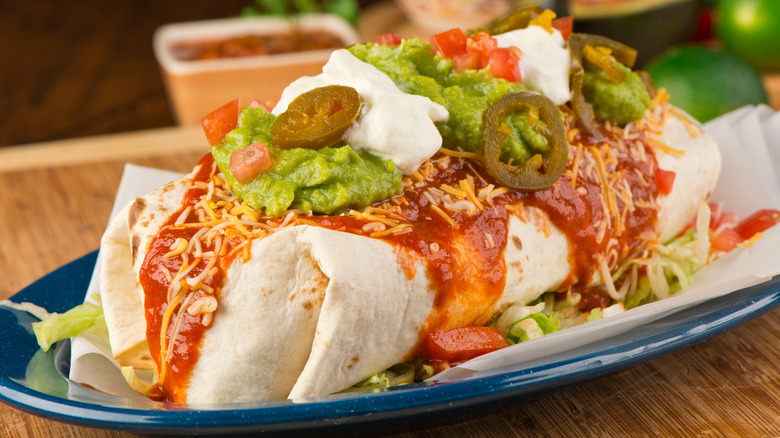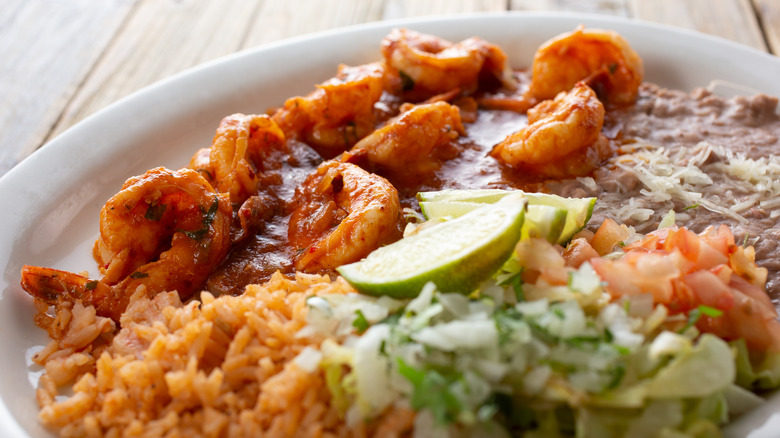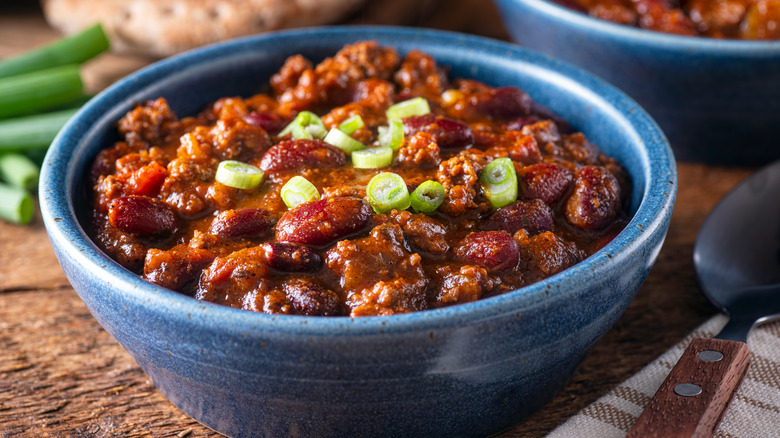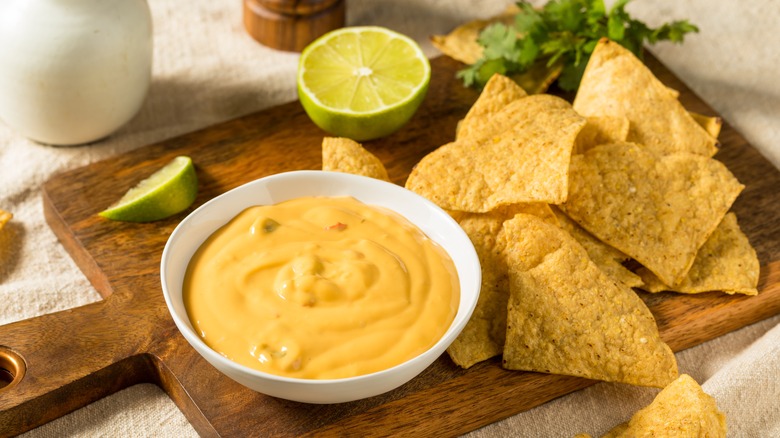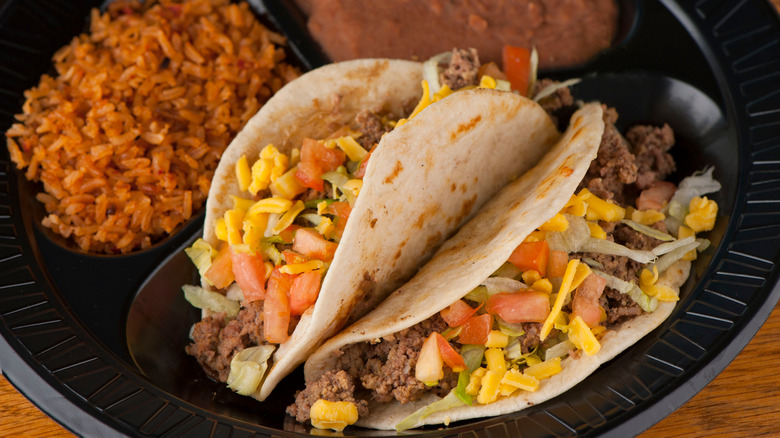What Makes Tex-Mex Different From Mexican Cuisine?
Fusion cuisine — the term brings to mind foods with a shocking clash of origins. The Mexican lasagnas, burrito-style sushi, and curry risottos of the food world. A movement that appeared in the U.S. during the 80s and 90s and never disappeared, dragging alongside it skeptics of authenticity. And while a new wave of 'chaos cooking' pushes fusion into a brash but delectable direction (per Eater), there's older culinary intermingling, too. The kind that now is assimilated into regional cookery (like Bánh mì) or deemed as a new cuisine in itself — American-Chinese, Cajun, and Tex-Mex, reports Auguste Escoffier School of Culinary Arts.
In the case of Tex-Mex, investigating its differentiation is especially tricky. After all, esteemed dishes like tacos, barbacoa, and tamales (via Beef Loving Texas) are found on both sides of the border. Despite their similarities, the two cuisines do have some identifiable characteristics. Let's dive into them.
What is Tex-Mex?
Tex-Mex cuisine serves up classic dishes like tacos, burritos, tamales, chimichangas, and more, but with ingredients and techniques unique to Texas. The most prominent distinction is the spice base — rather than fresh chilies, Tex-Mex reaches for chili powder made with cumin and oregano. Cheese, particularly cheddar jack, is another hallmark. Tortillas, in chip form, are prevalent, but when it comes to tacos, it's usually flour or hard shell, unlike corn in Mexico, reports Tijuana Flats.
In an interview for The Splendid Table, food writer Robb Walsh notes how Tex-Mex is a regional variety of American cuisine rather than a type of Mexican cuisine. Mostly consumed in restaurant settings, it doesn't have a strong home-cooking basis. However, it does interlink with the generational cooking of Tejanos — Spanish-speaking natives of Texas from times before American rule. Their culinary techniques showcase both a cross-cultural connection and how the cuisine emerged in parallel. Let's dive into Tex-Mex's history.
The history of Tex-Mex
Tex-Mex's fusion of influences closely mirrors the history of the Lone Star State. Before European arrival, Texas was inhabited by indigenous people for thousands of years. When the Spaniards arrived, they set up missions, the ground zero of culinary crossover. Ingredients like cumin carried over from the Canary Islands, fused with peppers, native to the Americas. The first distinctively Tex-Mex dish to emerge was chili con carne, explains Taste of Home.
The dish entered the public eye in San Antonio, what's considered to be the epicenter of Tex-Mex cuisine. During the 1870s, women known as chili queens started serving the chili streetside, garnering an abundance of media attention. In 1875, the term Tex-Mex was first coined, an abbreviation of the Texan-Mexican railway. Only during the first half of the 20th century did the name become associated with the cuisine. Promoted through Texas restaurants serving combo plates, the characteristic components of melted cheese and sour cream started to integrate with Tejano cooking. Nachos emerged in the 1950s, and fajitas spread from the Rio Grande Valley in the 1970s. Tex-Mex is dynamic by nature — new culinary innovations continue to emerge in restaurants across the Lone Star State (via First We Feast).
What dishes are Tex-Mex?
Tex-Mex cuisine encompasses a smaller, more defined set of dishes than Mexican food. Fewer ingredients are utilized, and techniques are often more straightforward than south of the border — there's not a Tex-Mex equivalent for a laborious dish like mole. While tacos or enchiladas may appear in both cuisines, there are a few dishes exclusive to Tex-Mex cuisine. With its Native-American origins and ties to the emergence of the cuisine, chili con carne continues to be the most iconic Tex-Mex food. Fajitas, now a classic at Tex-Mex restaurants, are another notable example of heavily Mexican-influenced American creation, notes Thrillist.
Additionally, it's impossible to neglect the cuisine's penchant for cheesy creations. There's queso, the cheesy dip that's a beloved appetizer in Tex-Mex. And who can neglect nachos — the beloved party snack is built for elaboration or simplicity. The cuisine's interpretation of enchiladas is loaded with cheese, too. Although Serious Eats notes it's not just the cheese that distinguishes them from Mexican cuisine but also the rich flour-based sauce.
Why Tex-Mex is an authentic cuisine
With many Tex-Mex classic dishes advertised as Mexican food through the 1970s, the two cuisines have historically been tricky to distinguish. In the 1972 cookbook "Cuisines of Mexico," American-British author Diana Kennedy delineated the two, classifying combo plates served with rice, beans, cheese, and the like as inauthentic interpretations of Mexican cuisine. Although disparaging to Texan chefs, her comment initiated the cementing of Tex-Mex as an independent cuisine (via History).
With its interlinking to fusion — a term sometimes unfashionable amongst diners — Tex-Mex is susceptible to dismissals like Kennedy's. However, it's important to note authenticity is a subjective social construct especially prone to the fixation on immigrant cuisine, per Eater. So instead of examining whether Tex-Mex matches culinary parameters, it should be celebrated as its own cuisine. And to aid with its comparison to across the border, it's one that can exist in parallel to Texan Mexican food, notes chef and writer Adán Medrano for the New York Times. With many Mexican restaurants in America serving Tex-Mex classics and dishes from Mexico on one menu, Medrano advances recognition of specifically Texas-Mexican creations. A promotion of indigenous pre-Spanish cooking styles, such nomenclature aids with both appropriation and dismissals of Texan cuisine. And while the line between Tex-Mex and other cuisines can certainly be tricky, the food's delicious flavors are a certainty.
